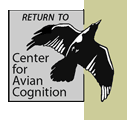


| Content Pages | ||
|
Keas and Kakas |
||
|
|
||
| People | ||
|
Alan B. Bond Judy Diamond |
||
|
|
||
| Docs & Links | ||
|
Publications Books Links |
||
|
|
||
The Ecology, Evolution, and Behavior
of Keas and Kakas
Keas (Nestor notabilis) are omnivorous olive-green parrots endemic to alpine scrub and mountain beech forests on the South Island of New Zealand. They are compulsively neophilic, fearless, persistent, and ingeniously destructive. They congregate around rich food resources, displaying a complex, stratified social system; juveniles associate with both related and unrelated adults for several years after fledging, following them around and apparently imitating their foraging behavior. And they show more elaborate and ritualized social play than any other species of bird. But what primarily attracted us to the species was the suggestion that they were "open program" animals, species that were specialized for learning and that displayed an unusual ability to adapt to changing conditions and circumstances.
Social Foraging and Ontogeny
We conducted three seasons of field observations on a banded population of keas at a rubbish dump outside of Arthur’s Pass National Park, obtaining quantitative recordings of foraging and social behavior from 38 keas of both sexes, including substantial numbers of all four distinguishable age classes – fledglings, juveniles, subadults, and adults. We used hypergeometric probabilities to define dissimilarities between behavioral events and compared activity patterns across sex and age classes with principal coordinates analysis. Keas displayed characteristic differences according to sex and age in foraging ability and in the social behavior used to obtain access to resources. Adult males performed most of the excavation that uncovered new food resources. Fledglings explored and manipulated objects almost continuously, but they discovered little food on their own and were commonly fed directly by adults. Juveniles obtained the highest foraging yields for the amount of time spent searching of any age class, aided by appeasement behavior that gave them preferential access to foods discovered by adults. Kleptoparasitism served as a primary foraging strategy for subadults, who were otherwise commonly displaced from any food resources they discovered. Females were subordinate to males of any age and primarily fed by gleaning small items from around the edge of the aggregation. We concluded that social factors influenced the acquisition and display of foraging expertise in this species in different ways at different stages of development, and that social transmission during group foraging was a far more complex phenomenon than had been hypothesized in the literature. Our initial field study (Diamond & Bond 1991) was broadened into a book-length monograph on kea behavior, biology, and evolution, published by the University of California Press (Diamond & Bond 1999).
Comparative Studies of Social Play
In our monograph, we argued that many of the more unusual features of kea behavior could be considered as specific adaptations to their harsh and unreliable habitat in the high alpine regions, which suggested a fertile ground for subsequent comparative research. The species most closely related to the kea is the kaka (Nestor meridionalis), a parrot from the more equable, lowland temperate rainforests of New Zealand. Because of their close phylogenetic relationship, one might expect keas and kakas to display similar behavior patterns, but kakas sociality is strikingly different. Kakas show more ritualized behavior patterns, particularly in the context of aggression, and juvenile kakas are independent of adults at an earlier age. And although kakas display very complex and sophisticated foraging techniques, at least as adults, they show much less interest in novel food items. These observations provided the basis for several additional years of field work, in which we made extensive recordings of social play from both keas and kakas, examining the two species differed in behavioral flexibility. A quantitative comparison of play behavior in keas and kakas was published in Behaviour. We also published a larger review article on the incidence of social play in birds, testing for differences between avian taxa, as well as for correlations between play complexity, brain size, and age of first reproduction. We found that several bird families with large numbers of playful species -- corvids, parrots, and hornbills -- had larger relative brain sizes than would be predicted from a class-level allometric regression, but brain size was not associated with the complexity of social play among genera within taxa. Play complexity within parrots and corvids was, however, significantly associated with the age of first reproduction. The likelihood of complex social play appeared to increase when delayed reproduction is accompanied by persisting relationships between adults and post-fledging juveniles, an intriguing parallel to the incidence of social play in mammals. This line of research was published in Diamond and Bond (2003 and 2004) and Diamond et al. (2006).
Vocal Dialects in Keas and Kakas
We have recorded vocalizations, both spontaneous calls and responses to playback, at a number of locations throughout the range of both keas and kakas, documenting the vocal repertoires of the species and quantifying their geographic variation. The initial results have been exceedingly interesting, suggesting that keas and kakas exemplify two distinctive patterns of parrot sociality, patterns that are echoed in the behavior of a broad range of other parrot species. The initial work from this research program, on vocal dialects in keas, was published in Bond & Diamond 2005, and a detailed description of vocal repertoires in these species is included in our book on cognition and behavior in wild parrots (Bond & Diamond 2019), placing such divergent strategies in the broader context of the entire group.
